The Story of the Universe: Difference between revisions
No edit summary |
|||
| Line 207: | Line 207: | ||
The first generations of stars filled out the periodic table through nuclear processes in their interiors, and through the shockwaves that ripped them apart. They left behind more black holes that merged with even larger black holes into the billion solar mass black holes that would become the nuclei of some of the first galaxies !!! | The first generations of stars filled out the periodic table through nuclear processes in their interiors, and through the shockwaves that ripped them apart. They left behind more black holes that merged with even larger black holes into the billion solar mass black holes that would become the nuclei of some of the first galaxies !!! | ||
== First Galaxies == | == First Galaxies and Quasars== | ||
900 Million Years After the Big Bang | ''''900 Million Years After the Big Bang'''' | ||
Revision as of 17:43, 16 April 2012
NOW YOU KNOW: THE STORY OF THE UNIVERSE
As we've seen before, when temperatures and pressures are right for something to happen ... it will ... and it did.
First 3 Minutes
The mystery of gravity and the inflation period
- First 10-43 second (0.0000000000000000000000000000000000000000001 second)
The first 10-43 second is obscured by our lack of knowledge of how gravity works, but we know that the appearance of space and time marked the beginning of the universe, and that matter and energy arose as a random fluctuation allowed by quantum theory. These fluctuations grew by gravitational attraction to become the first stars and clusters of galaxies. The Cosmic Background Radiation which we see today originated about 300,000 years after the beginning of time. and the regions of higher density we see in it must have spanned distances far greater than 300,000 light years across. For that to occur, the Universe itself must have expanded faster than the speed of light at a very early time. This epoch is called "inflation".
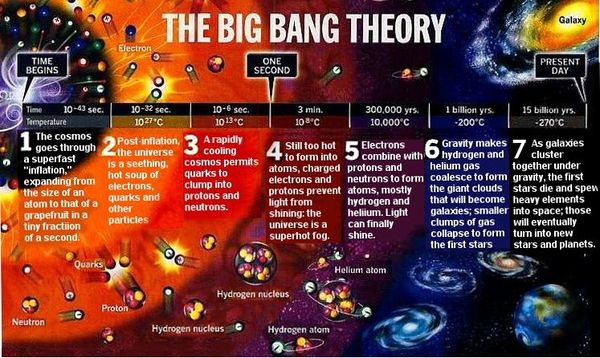
History of the Universe
- 10-32 seconds (0.00000000000000000000000000000001 of a second)
- 1027 K (1,000,000,000,000,000,000,000,000,000 K)
- Photons, little packets of energy, become matter
- E = mc2 or m = E/c2
By 10-32 seconds the universe had inflated enormously and the first particles appeared in a primordial soup of quarks and gluons, electrons, neutrinos, and many other particles. These particles and their behavior may be related by string theory.
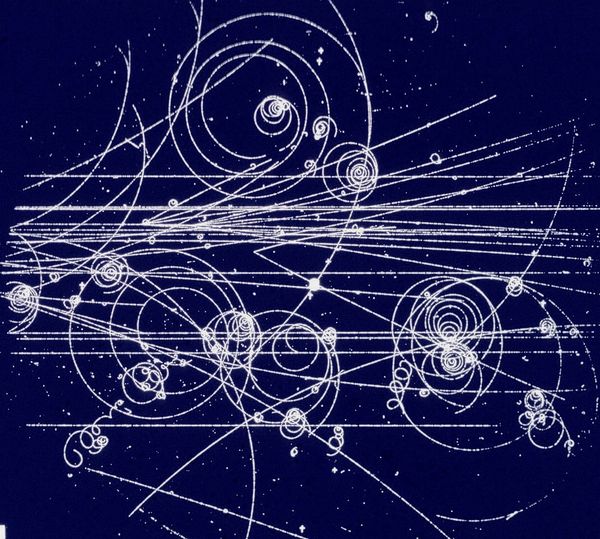
Bubble chamber showing tracks of free electrons and other particles
- 0.00001 to 0.0001 seconds after the Big Bang
- 1013 K (10,000,000,000,000 K)
- The first protons and neutrons
By 10-5 seconds, quarks linked up in trios to make protons (hydrogen nuclei).
By 10-4 seconds, the universe was left with 5x more protons than neutrons.
- 1 second
- 1010 K (10,000,000,000 K)
- Neutrinos on the loose
Neutrinos have no charge and barely interact with protons, neutrons, or electrons. They easily pass through even dense materials today. The early Universe was so dense that neutrinos scattered and could not get through. But, after one second, the universe had expanded enough that it became transparent to neutrinos, With almost no mass and traveling almost at the speed of light, they now fly around the universe forever.
- 3 minutes and 42 seconds
- 108 K (100,000,000 K)
- First nuclei
Next 300,000 Years
After 3 minutes and 42 seconds, the universe was dark energy, dark matter, light and ordinary matter in the form of electrons, protons and neutrons. As it cooled below 100,000,000 K, the first stable nuclei of helium appeared. Most of the ordinary matter remained hydrogen, with simply a proton for a nucleus, but 25% of it was now in the form of helium with two protons and two neutrons.
After 1 year, its temperature was about that in the center of a star like the Sun, 15,000,000 K, and it was cooling gradually.
- 300,000 years later
- 104 K (10,000 K)
- Cosmic Background Radiation or "First Light"
During the first 300,000 years, the universe cooled from 1027 K (that's 1,000,000,000,000,000,000,000,000,000 K, or a trillion quadrillion Kelvin) down to 10,000 K.
With such extreme heat, photons that were gamma rays, x-rays, ultraviolet, visible and infrared light made the universe extremely bright. It would have been like being below the surface of the star Sirius.
At temperatures higher than 10,000 K, atoms of hydrogen and helium collided with so much energy that their electrons were knocked free. Neutral atoms were rare, and the universe was a dense gas of hydrogen nuclei (protons), helium nuclei (two protons and two neutrons), and electrons. Photons didn't travel very far in this mix because they were scattered by the free electrons, just as they are inside a star.
But, at temperatures lower than 10,000 K, the energies were small enough that atoms retained their electrons after colliding. All the free electrons in the universe combined with the atomic nuclei to make neutral atoms. With mostly neutral hydrogen and helium atoms, and few free electrons, the universe was transparent to light. Photons were "free" to travel forever.

Evolution of the universe showing the time when the cosmic background radiation was emitted
After 300 to 400,000 years, photons, previously absorbed by free electrons, were released to travel through the universe at the speed of light. This was the beginning of the Cosmic Background Radiation.
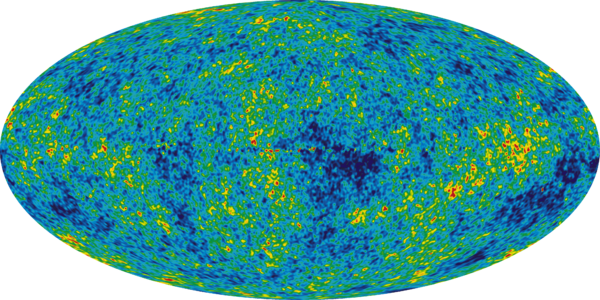
The cosmic background radiation we see today. Credit: NASA/WMAP Science Team
The original photons were from a dense gas at 10,000 K, and were mostly ultraviolet and visible light. Today, red-shifted by z=1000, they appear to be from a very cold 3 K source (2.725 degrees above absolute zero), and most of the light is at very long wavelengths, "microwaves."
Looking at slight deviations in the Cosmic Background Radiation, we can tell there is unevenness in the early universe, and how we are moving with respect to the matter from which it last scattered.
The Dark Age
Which wasn't really dark at all.
A "Dark Age", lasting millions of years, followed the last scattering of the cosmic background radiation from the ionized gas of the early universe. This period is called "dark" because there were no stars, but it wasn't really dark at all. Photons, now redshifted to be mostly visible and near-infrared light, flew among the helium and hydrogen atoms, making the universe at that time glow red in all directions.

During the Dark Age, before stars, the gas was nearly 1000 K, and the universe glowed in the infrared and red like an electric hotplate.
Locally, Newton's Law of Gravity
F = G mM/R2
governed what happened next. Little by little, regions that were slightly denser grew more dense under their own gravity. Free of the heavier elements that limit the growth of today's new stars, these collapsing protostars grew to exceptional size and became a first generation luminous blue supergiant stars.

Slightly denser regions began to collapse under their own gravity
Mega-Giant Stars Came Before Galaxies
Although galaxies are made up of stars today, in its first 100,000,000 years the early universe was like one dense galaxy full of bizarre mega-giant hot blue stars, 100 to 10,000 times the mass of the Sun, and a million times brighter.
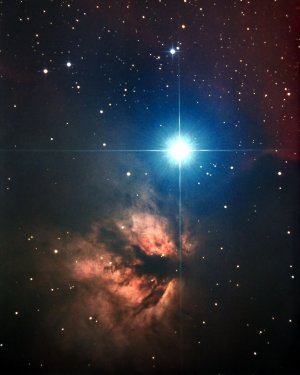
Alnitak, the easternmost star in Orion's Belt
The first stars looked like Alnitak in Orion's belt, only 100's of times more massive, a million times brighter, and lacking the carbon, nitrogen, oxygen, iron and other heavier elements we find in stars today.
No 1000 solar mass stars are known today. The largest star we know is LBV 1806-20, with only 150 solar masses. Its size was limited because heavy elements caused the cloud from which it formed to fragment into small pieces. In the early universe there were no heavy elements! Very large stars stars could form.

Artist's rendition of LBV 1806–20, a 150 solar mass star that glows with the brilliance of 49 million Suns
These first mega-giant stars were so massive that they consumed all their hydrogen fuel almost as soon as they were born. When they exploded in energetic supernovae, expanding shockwaves compressed surrounding gases and triggered new stars to form. Supernovae from some of these stars provided the universe with its first atoms of carbon, nitrogen, oxygen, silicon and iron, and left behind massive black hole remnants that would join to become the nuclei of galaxies.

Supernova shock waves
Proto-Galaxies Appeared
The first proto-galaxies formed around the concentrations of dark matter, ordinary matter, and black holes that were present after the first stars. Shock waves from supernovae in the first galaxies created uneven densities, and triggered the formation of new stars, stars of all kinds. Stars of low mass evolve very slowly, and may still be in the galaxy billions of years later. Stars of large mass would use their fuel quickly, explode as supernovae, enrich the galaxy even more, and trigger a new cycle of star formation.
In galaxies like the Milky Way all the stars are enriched to some degree. The oldest stars of the globular star clusters have the least heavy elements, and the youngest stars of the spiral arms have the most. Galaxies appear to have been formed from material that had already been cycled through stars at least once.
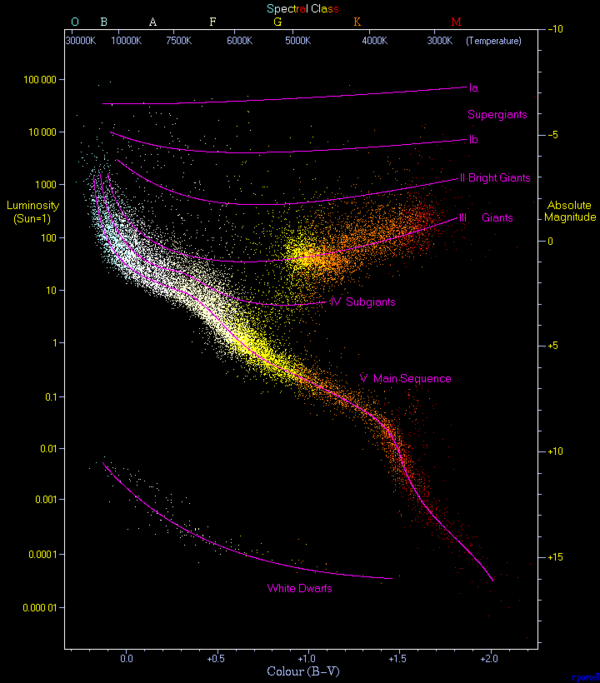
Humongous bright blue stars triggered the creation of all types of stars in the new first galaxies
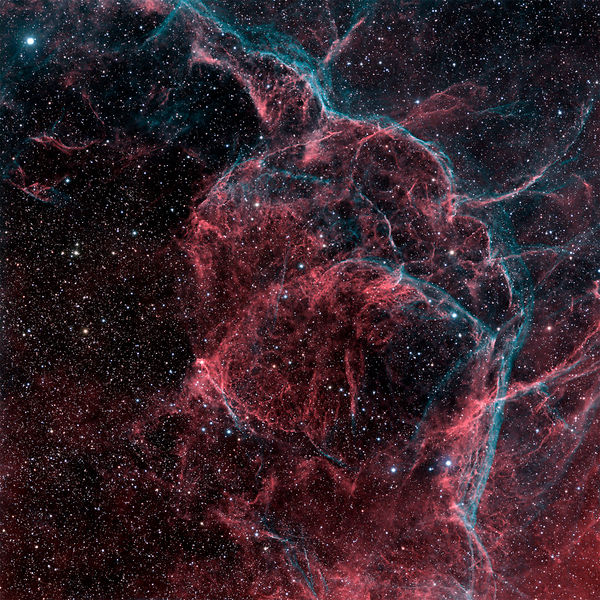
Vela supernova remnant
Supernova remnants from the first giant 100 solar mass blue stars in a galaxy contained all the elements of the periodic table, to be caught up in second and third generation stars.

The first generations of stars filled out the periodic table through nuclear processes in their interiors, and through the shockwaves that ripped them apart. They left behind more black holes that merged with even larger black holes into the billion solar mass black holes that would become the nuclei of some of the first galaxies !!!
First Galaxies and Quasars
'900 Million Years After the Big Bang'
Spectra from the first galaxies show that they contain heavier elements from an earlier population of giant stars and supernovae. Among the first galaxies are those with supermassive black holes in their centers, billions of times more massive than "normal" solar-mass black holes! These are the quasars, that we see at great distances because their centers are so bright.
quasar
Quasars are active galaxies gathering matter in the dense early universe. This one is seen when the Earth was just forming.
Quasars are called active galaxies because their central black hole is thrashing infalling matter into vortices that emit enormous amounts of energy and they eject jets of matter thousands light years out into space.
Quasars appear much like the nearby active galaxy M87, only millions of times brighter at the central nucleus. Below we see a distant quasar, 10 billion light years (3 billion parsecs) away, through a cluster of galaxies "only" 7 billion light years away. The cluster's gravity acts as a lens, focusing the light from the bright yellow quasar and its super bright core into 4 bright blue-white star-like spots.
QUASAR LENS
The four bright blue-white points are actually images of a single distant quasar made visible by the gravity of a cluster of galaxies that bends the light on its way to us: a gravitational lens Credit: K. Sharon and E. Ofek, ESA, NASA
Since it takes light 13 billion years to reach us from these quasars, the earliest galaxies must have formed at least 13 billion years ago. While there are a few nearby active galaxies, most quasars seem to have evolved into some of the quieter galaxies we see today in this later, less dense, universe.
m87
Some are still active galaxies such as M87 in the Virgo Cluster.
whirl
Galaxies are spiral, elliptical or irregular. Some galaxies collide, like the spiral Whirlpool galaxy near the Big Bear's tail seen here.
udf The most distant galaxies are seen as they were when young, and differ in appearance from those nearby.
Galaxies are Distributed Throughout the Universe in a Pattern Like Swiss Cheese
Surveys of the universe have revealed a foamy pattern in the distribution of galaxies and quasars. Billions and billions of them form clusters and filaments throughout the universe, tracing the dark matter we cannot see. Dark energy is present throughout space as well, and acts against gravity to continually increase the expansion of the universe.
There are large volumes of space that are mostly empty, and filaments of clusters of galaxies throughout. This short movie based on real data from the Sloan Survey shows the actual galaxy distribution through some slices of the universe.
We can simulate this too, by trying to understand how the universe got into its current state, and following the effect of the gravity to see clusters of galaxies developing in the early universe.
Second and Third Generation Stars May Have Planets
First generation stars began with hydrogen and helium, so they could have had no planets. All stars today are second and later generations stars, and they have heavier elements that were created in earlier stars. The Sun is a third generation star.
Some planets are familiar to us. Others are not. Some planets have life we are familiar with. Since meteorites have complex organic molecules such as amino acids, we expect other planets to have life forms, as well, albeit, less familiar ones.
planets
In the Milky Way Galaxy there is a star called the Sun which has planets
ducks
At least one of these, planet Earth, has familiar life
exoplanet
55 Cancri is another star in the Milky Way that has planets
aliens
55 Cancri has terrestrial planets that may have less familiar Life
When we look at the sky we are looking towards the rest of the universe and may see all these things, using the constellations as a map.
constellations See if you can find the constellations of Canis Major, Orion, Taurus, the Pleiades open star cluster, Betelgeuse the red giant, Sirius the brightest star in the sky, a double star, the Orion nebula, Alnitak near where we find the Horsehead nebula, and the Moon.
We can see beautiful starbirth nebulae where hydrogen and helium combine in Bok globules with heavy elements, dust and molecules from deceased stars to become protoplanetary disks, and then star systems with planets ...
starbirht Starbirth Nebula with bok globules and large hot blue Wolfe Rayet stars
and comets, snowballs that have tails when in the solar wind, and meteorites which are often pieces of comets, or part of the early solar nebula, some containing amino acids, the building blocks of life.
swan
Comet Swan
murchison
The Murchison Meteorite is a carbonaceous chondrite that has amino acids in it different from those found on Earth.
Sometimes comets and meteors come to Earth
tunguska In 1908, a comet or meteorite exploded just over Tunguska, Siberia. The impact flattened a forest the size of Rhode Island.
and may again when the asteroid 99942 Apophis returns on April 13, 2029.
In addition to light, the Sun sends us a solar wind that makes aurora around the Earth's magnetic poles, like the one in this video. The solar wind is made of charged particles -- mostly protons and electrons -- from the Sun, and the particles are deflected by the Earth's magnetic field and spiral around the field to the magnetic north and south poles of Earth. Similar aurora are seen around the poles of other planets with magnetic fields such as Jupiter and Saturn.
Aurora
An aurora occurs when the Earth's atmosphere glows in response to impact by charged particles from the Sun.
Will Earth be struck by a giant asteroid that will alter its life forms, as happened 65 million years ago when the dinosaurs went extinct, leaving their bones, fossils, and a layer rich in iridium from the giant asteroid that hit the Yucutan peninsula.
Or, will it be swallowed up by the Sun turning into a red giant in 5 billion years? Will it be sent out as part of a beautiful planetary nebula, adding to the other elements and compounds that may become another generation of stars and planets, while the Sun collapses to a white dwarf?
Fate of a sun-sized star
The Sun will become red giant, develop a planetary nebula, and end as a white dwarf.
Or, will it fly out into intergalactic space when our Milky Way galaxy encounters the Andromeda galaxy in about 3 billion years?
And what is the fate of the universe?
Fate of the Universe
According to Einstein's equations, the universe could accelerate its expansion and end in a Big Rip, such that even atoms would be torn apart by expansion near the speed of light. The equations also would allow it to collapse and fall back on itself into a Big Crunch and disappear into something like an enormous black hole. Observations of distant supernovae show that the universe is expanding at a faster and faster rate, inflated by dark energy. Will this be our fate, or could the universe be cyclic with a Big Bounce every few trillion years, or simply slowly stop expanding and come to an eternally frozen stand still.
future
Fate of the universe may be a Big Rip
In the meantime, we may feel very lucky to live on a planet so nice as this one, and may continue to do so for a few more billion years, until the Earth's orbit changes to a less habitable zone around a dying star.
There's No Place Like Home
The first images of Earth returned to us from space gave us an entirely new sense of our place in the universe, as you will hear in this video narrated by Carl Sagan.
The long and the short of it all is that we are very fortunate to live on a beautiful planet, near a modest-sized Sun, in a spiral galaxy called the Milky Way, in an amazing universe that we can, at least in part, understand.
Sherwood Gardens, Baltimore, Maryland
Spring at Sherwood Gardens, Baltimore, Maryland